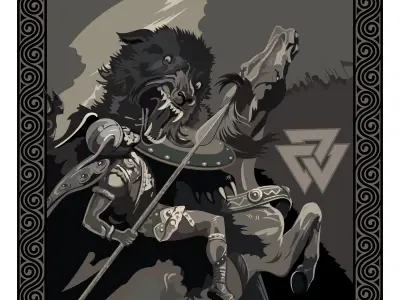"Yule tidings". Have you ever seen this greeting on a Christmas card? While we’re on the subject, have you ever...
- Decorated a Christmas tree?
- Exchanged gifts with loved ones during the holidays?
- Gone carol singing?
- Kissed someone under mistletoe?
If you answered "yes" to any of the above, then you have actually partaken in a Pagan Christmas tradition!
Surprised? From a historical point of view, it makes perfect sense. Back when Christianity was still establishing itself as a new religion in Europe, the Church had to convince the majority of the population to give up their Pagan beliefs and convert. They soon realised that letting them keep their Pagan holidays and traditions (and incorporating them into Christianity) would make for a much smoother transition, so it made sense to intertwine the two to create a Pagan Christmas. It actually took a few centuries for the 25th December celebration of the birth of Jesus Christ to become canon; scholars today believe it to be more likely that Jesus was actually born in spring. So why was it so important to make sure the Christmas period coincided with the Winter Solstice?
Looking to Nature
To understand any holiday and the mythology behind it, we should look at nature. Specifically, how nature’s manifestations in the physical world were perceived by our ancestors; how these affected their daily life.
For those living in the Northern Hemisphere, the Winter Solstice (21st December) symbolised the end of the darkest period of the year and the journey towards the rebirth of the Sun — after the Winter Solstice, the Sun would stay on the horizon for longer each day.
This had very practical, as well as spiritual, aspects. On the practical side, after a harsh winter that had likely depleted food stores, the Winter Solstice was a reminder that their families wouldn’t starve, as crops would soon start growing again and livestock would start giving birth.
This rebirth became a cause for celebration; an acknowledgement of life and abundance winning out over death and famine.
A Celebration of birth
That rebirth of life/rebirth of the Sun was celebrated across various Pagan traditions throughout the Northern Hemisphere. The birth of Sun Gods such as Mithra (worshipped in Persia and subsequently in the Roman Empire) and Horus (worshipped in Egypt) was celebrated around the Winter Solstice: both Pagan Gods are thought to share similarities with Jesus.
According to the Ancient Greek historian Plutarch, Horus, the Egyptian God of the Sky who commanded the Sun and the Moon, was born during Winter Solstice. Horus was frequently depicted as a naked baby sucking his thumb, sitting on a lotus flower with his mother, Isis — which has been said to have informed Christian depictions of the Holy Infant. To celebrate his birth, Egyptians would decorate their homes with palm tree branches; a symbol of resurrection and rebirth.
Even more parallels can be drawn between Jesus and Mithra, a Zoroastrian deity of light who was incorporated into the Roman pantheon. Mithra came to Earth to "save humanity from evil" and his birth was, in a way, an Immaculate Conception (as he was born of a rock). Mithra’s birth was celebrated on the 25th December by lighting torches and candles, his Holy Day was Sunday and he was known as the "Invincible Sun" and the "protector of cattle". He died and was resurrected in order to become an intermediary between man and the God of Light. Sound familiar?
Customs, Symbolism and the Influence of the Roman Empire
This is not to say that Christianity and the celebration of Christmas were a copy of Pagan religions and customs. Most religions have borrowed elements from each other and many of the underlying religious themes, like sacrifice and resurrection, are universal. As we’ve seen, however, symbols and customs matter — and as Christianity was officially adopted by the Roman Empire and spread across Europe, Pagan symbols and customs were "baked" into Christian practices.
In the case of Christmas, the merrymaking traditionally accompanying the Roman celebrations of Saturnalia was a big influence. Saturnalia, originally celebrated on 17th December to celebrate the Roman God Saturn, soon became an extravagant affair that lasted a whole week. People would close their businesses and celebrate. There was ample food and drink, they would decorate their homes with greenery and hang tin ornaments from trees and bushes, exchange gifts and, finally, roam the streets naked, singing carols (they were Romans, after all). Interestingly enough, when Christianity became canon, Christmas celebrations extended to an 8-day period, which later evolved into "the 12 days of Christmas".
Merry Pagan Christmas
Germanic and Scandinavian customs and symbols were also incorporated in what we will now lovingly call Pagan Christmas. The Winter Solstice period was called Jul in Old Norse — a word still used today, as there is no actual word for "Christmas" in modern Scandinavian languages. (On a similar note: in Latin languages such as Italian, French and Spanish, wishing someone a "Merry Christmas" literally translates to "Happy Birth", Natale, Noël and Navidad respectively, without any mention of the name of Christ. It is argued that this reflects back to a time when the Winter Solstice celebrated the birth of the Sun.)
Yule Log
The Yule Log, which these days you’ve probably encountered in the form of a delicious cake, was an Old Norse tradition; a big log was thrown into the hearth, as a symbol of the Sun who the Norsemen believed to be a giant wheel of fire, rolling away from the earth in the winter.
The "Original" Christmas Tree
The "original" Christmas trees were the Norwegian Spruce or Fir trees (both tree types were in abundance in the Scandinavian forests). Norsemen would decorate the trees with fruit and candles to honour their Allfather God, Odin — who is also probably the inspiration behind Santa Claus, but that’s a story for another time.
Meeting Under the Mistletoe
As for mistletoe? It was associated with Frigg, the Norse Goddess of Love, whose beauty was unparalleled. Mistletoe was considered a symbol of reconciliation, as Viking warriors meeting under mistletoe would have to lay down their arms. The Celtic Druids in the British Isles would gather mistletoe in celebration of the Winter Solstice. And although in Christian lore the plant is considered unholy, as mistletoe was supposedly one of the woods from which Christ’s Cross was made, it is interesting to see that the Pagan tradition has, in a way, won. What better way to celebrate a Pagan Christmas than kissing your beloved (or your enemy, if you’re a Viking) under the mistletoe?
At the time of publishing, entering the code DECIPHER at checkout will reduce the price of our
Symbology Diploma Course by 50%.





